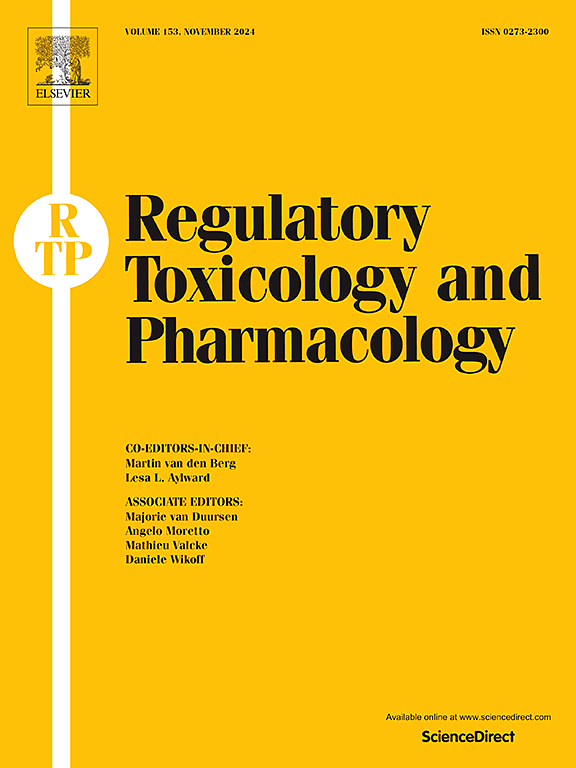新型盐酸环苯扎林鼻喷雾剂的临床前安全性、耐受性和药代动力学
IF 3.5
4区 医学
Q1 MEDICINE, LEGAL
引用次数: 0
摘要
这些研究检查了大鼠和狗反复鼻内给予盐酸环苯扎林的影响。在大鼠中,剂量高达1.05毫克/只动物/天,持续28天,没有死亡或毒性。体重、采食量、眼科和神经行为评估以及临床病理评估均未受影响。显微镜检查显示鼻腔给药部位有少量非不良增生。其他器官和组织未见组织病理学改变,NOAEL为1.05 mg/只/d。在狗中,在14天内,高达10.5 mg/只/天的剂量耐受性良好,仅观察到轻微的局部刺激,如鼻痒,给药后迅速消退。体重、食物消耗和综合神经行为评估,包括心电图检查和反射测试,均未显示不良反应。血液学、临床化学和尿液分析的变化很小且不依赖剂量。鼻腔和其他解剖结构的显微镜检查显示轻微的非不良变化,嗅觉上皮、嗅球或大脑没有明显的组织病理学发现。这些结果表明,盐酸环苯扎林鼻喷雾剂耐受性良好,大鼠的NOAEL为1.05 mg/动物/天,狗的NOAEL为≥10.5 mg/动物/天,提示临床应用时鼻内给药是安全的。本文章由计算机程序翻译,如有差异,请以英文原文为准。
Preclinical safety, tolerability and pharmacokinetics of a novel cyclobenzaprine hydrochloride nasal spray
These studies examined the effects of repeated intranasal administration of Cyclobenzaprine hydrochloride in rats and dogs. In rats, doses up to 1.05 mg/animal/day over 28 days showed no mortality or toxicity. Body weight, feed intake, ophthalmological and neurobehavioral assessments, and clinical pathology evaluations remained unaffected. Microscopic examinations revealed minimal non-adverse hyperplasia at the administration site in the nasal cavity. No histopathological changes were observed in other organs or tissues, establishing the NOAEL at 1.05 mg/animal/day. In dogs, doses up to 10.5 mg/animal/day over 14 days were well-tolerated, with only mild local irritation observed as nasal itching, which resolved quickly post-dosing. Body weights, food consumption, and comprehensive neurobehavioral assessments, including ECG examinations and reflex tests, showed no adverse effects. Hematological, clinical chemistry, and urinalysis variations were minimal and non-dose-dependent. Microscopic evaluations of the nasal cavity and other anatomical structures showed mild non-adverse changes, with no significant histopathological findings in the olfactory epithelium, olfactory bulb, or brain. These findings indicate that Cyclobenzaprine Hydrochloride Nasal Spray is well-tolerated with a NOAEL of 1.05 mg/animal/day in rats and ≥10.5 mg/animal/day in dogs, suggesting potential for safe intranasal administration in clinical use.
求助全文
通过发布文献求助,成功后即可免费获取论文全文。
去求助
来源期刊
CiteScore
6.70
自引率
8.80%
发文量
147
审稿时长
58 days
期刊介绍:
Regulatory Toxicology and Pharmacology publishes peer reviewed articles that involve the generation, evaluation, and interpretation of experimental animal and human data that are of direct importance and relevance for regulatory authorities with respect to toxicological and pharmacological regulations in society. All peer-reviewed articles that are published should be devoted to improve the protection of human health and environment. Reviews and discussions are welcomed that address legal and/or regulatory decisions with respect to risk assessment and management of toxicological and pharmacological compounds on a scientific basis. It addresses an international readership of scientists, risk assessors and managers, and other professionals active in the field of human and environmental health.
Types of peer-reviewed articles published:
-Original research articles of relevance for regulatory aspects covering aspects including, but not limited to:
1.Factors influencing human sensitivity
2.Exposure science related to risk assessment
3.Alternative toxicological test methods
4.Frameworks for evaluation and integration of data in regulatory evaluations
5.Harmonization across regulatory agencies
6.Read-across methods and evaluations
-Contemporary Reviews on policy related Research issues
-Letters to the Editor
-Guest Editorials (by Invitation)

 求助内容:
求助内容: 应助结果提醒方式:
应助结果提醒方式:


